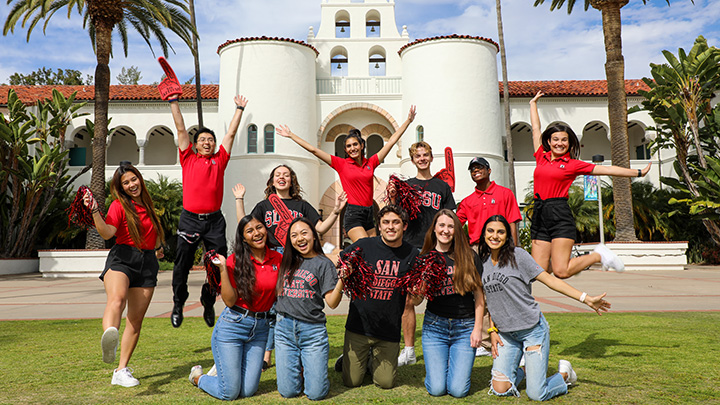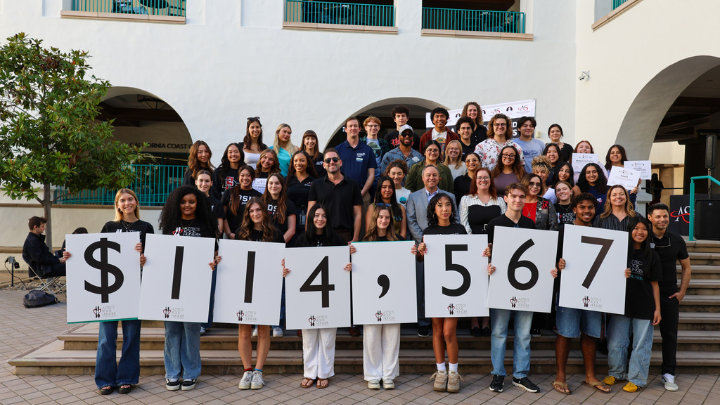San Diego State University’s enduring economic impact
SDSU continues to play a powerful role in advancing California’s economy, supporting tens of thousands of jobs, generating billions in statewide economic activity and fueling opportunity through education, research and community partnership.

A new economic impact analysis from the California State University system underscores San Diego State University’s far-reaching return on investment and role in advancing opportunity and driving economic growth throughout California ― with a total of $9.65 billion in industry activity driven by both the university and its alumni.
The CSU’s newly released Economic Impact Report, commissioned by the CSU Chancellor’s Office, places SDSU as the system’s top performer for the estimated number of jobs supported and the amount of tax revenue generated to support the region and state. Statewide, the report shows that SDSU supports 26,000 jobs statewide and generates $239.8 million in local and state tax revenue.
The report, based on a standardized systemwide model to measure operational, capital and student-spending impacts across each of the CSU’s 22 campuses, also shows that for every dollar the state invests in SDSU, $12.66 in economic activity is generated across California. When factored in the increased earnings of SDSU alumni, that impact grows dramatically, reaching $38.28 in statewide industry activity for every dollar invested ― one of the highest of all California universities.
“This study reaffirms that SDSU is an extraordinary investment, for students, taxpayers and the state,” said SDSU President Adela de la Torre.
“With every dollar fueling both opportunity and economic growth, we are demonstrating that our institution delivers lasting returns,” de la Torre said. “We are proud to stand among a select group of institutions that deliver exceptional educational value, drive innovation and strengthen the economic and civic fabric of our communities.”
Top performer in the CSU
The study evaluated several metrics to assess two factors: each university’s contributions and spending and the resulting benefits for students, alumni and the wider community. Those metrics included:
- Economic and industry impacts: total jobs supported, employee wages and salaries and tax revenues generated by university activities.
- Student and alumni success: enrollment, degree completion and post-graduation earnings.
- Societal impacts: outcomes and benefits associated with university research.
Throughout the CSU system, SDSU either ranks No. 1 or is a top producer in several areas, including the following:
- The average graduate earns $505,286 more in present-value career earnings than peers without a bachelor’s degree.
- The annual rate of return, at 26.7%, exceeded the U.S. stock market’s 30-year average of 10.1%.
- Graduates recover their total educational investment, including opportunity costs, within six years of graduation.
- SDSU researchers successfully secured more than $620 million in external funding over the last three years.
SDSU alumni also had significantly higher median incomes attributed to their degree, totaling $5.3 billion. That income contributes directly to 31,300 jobs, $6.6 billion in industry activities and $519 million in state and local tax revenues throughout California, according to the report.
Student success equals alumni success
Today, the more than 500,000 living alumni ― most of whom remain in the San Diego and Imperial Valley regions ― are powering industries in education, health care, business, engineering and public service.
“An SDSU degree doesn’t just open doors for individual graduates, it ensures our communities continue to have the professionals they rely on every day to thrive,” said Daniel Newell, SDSU’s executive director of Career Services.
SDSU continues to expand degree programs and partnerships that meet regional and national workforce needs. Recent initiatives include new nursing degrees, a Bachelor of Science in Artificial Intelligence and Human Responsibility – the first of its kind in the CSU system – and expanded collaboration with local institutions such as the San Diego Unified School District and Kumeyaay Community College. Also, about 87% of students participate in work experience before graduation.
At SDSU’s Career Services, the team has deepened connections across sectors through its Industry Engagement strategy, which in just one year led to about 10,000 new employer partnerships and a 200% increase in recruiting events. The university now maintains more than 60,000 industry relationships.
“For SDSU students, this reality underscores the lasting value of their degree. Our graduates are entering fields where their skills are indispensable,” Newell said. “Ultimately, the new report clearly demonstrates that the university is fueling not only economic development, but also social mobility, and that our graduates are needed more than ever.”
Additional evaluation forthcoming
As an important distinction, the CSU-commissioned report differs in approach and methodology from SDSU’s prior 2017 independent economic impact study, which estimated the university contributed $5.67 billion to the San Diego regional economy. The CSU commissioned report omits most alumni industry activity, as well as some research and most venue based impacts (e.g. events and spending generated by SDSU’s Viejas Arena and Snapdragon Stadium are not captured in the report).
The earlier analysis released in 2017 used a broader methodology, incorporating direct, indirect and induced impacts, venue related impacts and local supplier spending and alumni wage expenditures within the region.
SDSU plans to commission a new, independent study as early as 2026 to assess its total statewide economic impact across all measures. While the CSU study indicates the university’s economic impact in the form of industry activity amounts to about $6.3 billion statewide, early projections suggest that SDSU’s comprehensive contribution could approach $10 billion when all direct and alumni impacts are captured.
“While methodologies may vary, the story is consistent: SDSU continues to be one of California’s greatest public investments creating jobs, fueling innovation and opening doors of opportunity,” said Agnes Wong Nickerson, SDSU’s vice president for the Division of Business and Financial Affairs and chief financial officer.



